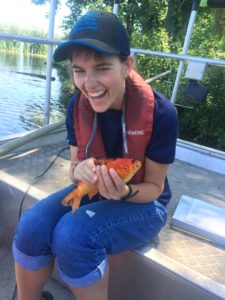Carp Management in Normandale Lake
Normandale Lake Carp Management

Carp are an invasive species of fish that cause water quality problems due to their bottom feeding behavior. They stir up lake bottom sediments, reducing water clarity and releasing phosphorus. They also uproot aquatic vegetation, destroying habitat for waterfowl and aquatic communities. A 2018 fish survey indicated that carp were at a level in Normandale Lake where management of the population is recommended for water quality purposes.
A follow-up fish survey was completed in 2019 to assess carp levels and the native fish population following the drawdown that was part of the Normandale Lake Water Quality Improvement Project. A large number of young of the year carp were found in the lake, indicating successful carp recruitment (survival to the juvenile stage) following the drawdown.

The Nine Mile Creek Watershed District (District) is working with Carp Solutions to determine the best methods for carp management in Normandale Lake. As part of the work in 2020, two box nets are currently located in Normandale Lake. A box net is a square net with mesh bottom and mesh sides lined with weighted line around each side causing it to lay flat on the bottom of the lake. The net will typically lie on the bottom of the lake (i.e. it does not cause non-target fish entanglement). Carp are trained to aggregate in the area of the box net with cracked corn (Bajer et al. 2010). The carp can then be selectively and effectively removed using the box nets at the baited sites. The carp are captured when the sides of the net are quickly lifted above the surface of the water to trap the carp that aggregate at the bait. The net is usually lifted at daybreak when most carp aggregate at the bait (Bajer et al. 2010). The District is working with Carp Solutions to try smaller net mesh sizing to capture not only the large carp in the lake, but also the young carp that were born after the lake drawdown.
Lake Cornelia and Lake Edina Goldfish Study
At the same time as the carp management work is going on in Lake Normandale, the District is working on a goldfish study on Lake Cornelia and Lake Edina.
Lake Cornelia and Lake Edina are shallow lakes with poor water quality that are on the state’s impaired waters list for excess nutrients. The District is working on projects to control nutrient levels (phosphorous) in Lake Cornelia and Lake Edina. Because water flowing out of Lake Cornelia eventually flows into Lake Edina, reducing the amount of nutrients coming out of Lake Cornelia will improve Lake Edina and downstream water resources.

An alum treatment was conducted in late May to reduce phosphorous levels in Lake Cornelia. Unfortunately, Lake Cornelia also has an infestation of goldfish. The lake is surrounded by potential nursery lakes. Goldfish are not native to Minnesota. When released to lakes and creeks, goldfish are destructive to native species and their habitats. They stir up the bottom sediment when they eat, increasing the cloudiness of the water, releasing nutrients that fuel algae growth, and impacting aquatic plant growth. Goldfish can survive in low oxygen conditions and can tolerate larger fluctuations in water temperature than native fish. This allows them to thrive and out-compete native fish species in certain conditions, reducing the biodiversity of the water body.
With the support of a grant from Hennepin County, the District is conducting a study with WSB to track movement of the goldfish to better understand their mobility, spawning patterns and likelihood to travel/spread within a lake system. The District is currently collecting a sample of goldfish to attach antennae to, before releasing them, so that their movements can be tracked. Finally, a goldfish removal method will be tested to determine effectiveness of stopping goldfish spread.
Watch a video about this project
References
Bajer, P.G., H. Lim, M.J. Travaline, B.D. Miller and P.W. Sorensen. 2010. Cognitive aspects of food searching behavior in free-ranging wild Common Carp. Environmental Biology of Fishes 88: 295-300.
